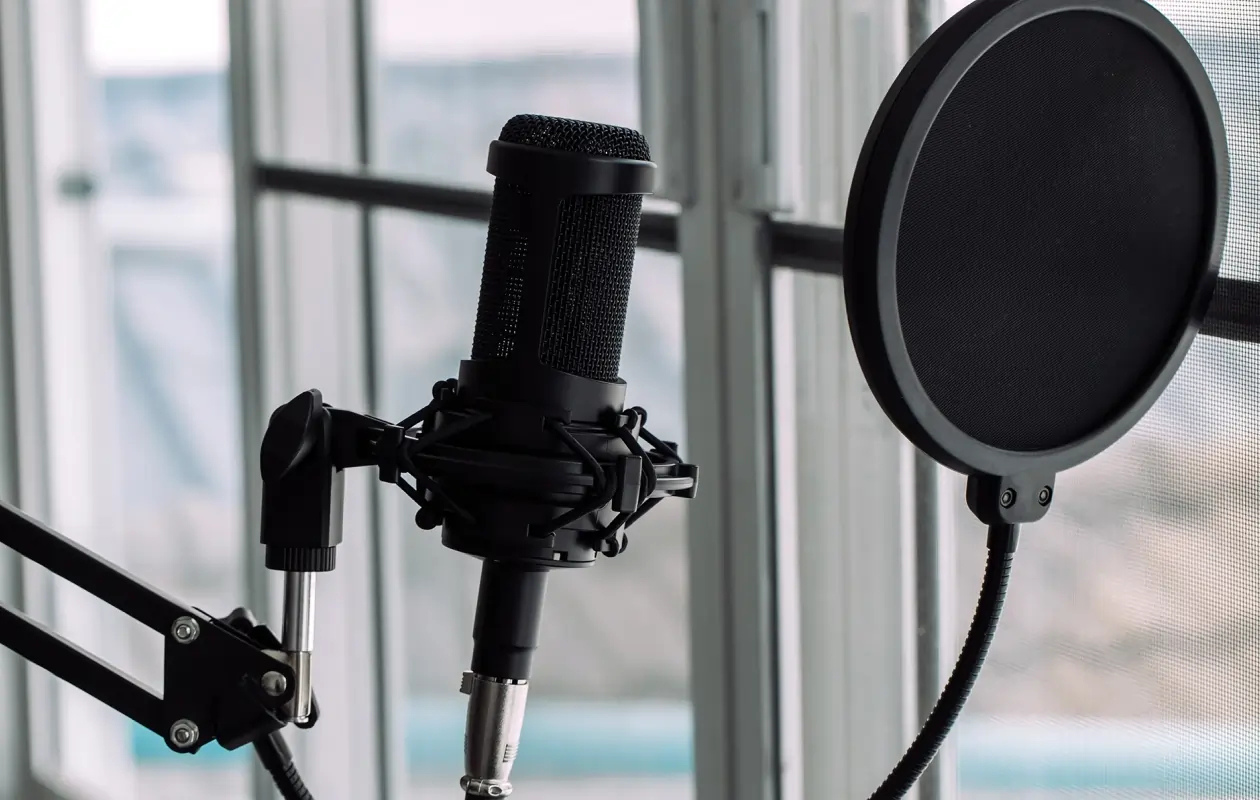Home>Devices & Equipment>Microphone>What Does The Screen In Front Of A Microphone Do


Microphone
What Does The Screen In Front Of A Microphone Do
Published: February 17, 2024
Discover the purpose of the screen in front of a microphone and how it affects sound quality. Learn about the importance of this component in microphone technology. Gain insights into microphone functionality and performance.
(Many of the links in this article redirect to a specific reviewed product. Your purchase of these products through affiliate links helps to generate commission for AudioLover.com, at no extra cost. Learn more)
Table of Contents
Introduction
When we think of a microphone, we often picture the sleek body, the sturdy stand, and, of course, the iconic screen in front of it. But have you ever wondered what that screen actually does? Microphones are essential tools for capturing sound, and the screen plays a crucial role in ensuring that the recorded audio is of the highest quality. In this article, we will delve into the purpose of the screen in front of a microphone, explore the different types of screens available, discuss the benefits of using a screen, and highlight important considerations when using one. Whether you're a professional audio engineer, a podcaster, a musician, or simply someone intrigued by the world of sound recording, understanding the significance of the screen in front of a microphone will deepen your appreciation for this fundamental piece of audio equipment.
The screen in front of a microphone is not merely a decorative element; it serves a specific function that directly impacts the quality of the recorded sound. By gaining insight into the role of the screen and the various factors to consider when using one, you'll be better equipped to make informed decisions when selecting and utilizing microphones for diverse applications. Let's embark on a fascinating journey into the realm of audio technology and uncover the secrets behind the unassuming yet indispensable screen in front of a microphone.
The Purpose of the Screen
The screen in front of a microphone, also known as a grille or a pop filter, serves multiple essential purposes in the realm of audio recording. One of its primary functions is to act as a barrier against unwanted noise and disturbances, such as plosive sounds and wind. Plosive sounds, which are bursts of air that occur during speech, can create disruptive bursts of low-frequency energy, leading to distortion in the recorded audio. The screen effectively diffuses these bursts, ensuring that the microphone captures a clean and natural sound without the interference of plosives.
Furthermore, the screen functions as a shield against wind noise, especially when recording outdoors or in environments with air circulation. By preventing gusts of wind from directly hitting the microphone diaphragm, the screen helps maintain the integrity of the recorded sound, minimizing the impact of unwanted environmental factors on the audio quality.
Additionally, the screen plays a crucial role in protecting the delicate internal components of the microphone. It acts as a physical barrier, safeguarding the diaphragm and other sensitive parts from dust, moisture, and accidental contact. This protection is vital for preserving the longevity and performance of the microphone, particularly in professional settings where equipment durability is paramount.
Moreover, the design of the screen influences the microphone’s frequency response and polar pattern, contributing to the overall tonal characteristics and directional sensitivity of the device. Different screen configurations and materials can modify the microphone’s sonic attributes, making it suitable for specific recording applications and environments.
Understanding the multifaceted role of the screen in front of a microphone illuminates its significance in ensuring pristine audio capture and protecting the microphone’s internal components. As we delve deeper into the world of microphones, it becomes evident that the screen is not merely a passive accessory but a vital component that profoundly influences the quality and reliability of recorded sound.
Different Types of Screens
Microphone screens come in a variety of types and designs, each tailored to address specific recording needs and environmental conditions. Understanding the distinctions between these screens is crucial for selecting the most suitable option for a given audio capture scenario.
One common type of screen is the foam windscreen, which is characterized by its cylindrical shape and porous foam material. Foam windscreens are particularly effective at mitigating wind noise and minimizing plosive sounds, making them ideal for outdoor recording and vocal applications. Their lightweight and portable nature further enhance their appeal for on-the-go audio capture.
Another prevalent screen variant is the metal grille, often found on dynamic microphones. These grilles are constructed from durable metal alloys, providing robust protection for the microphone’s internal components while allowing for optimal sound transmission. Metal grilles are renowned for their resilience and suitability for live performances and studio recording alike.
Pop filters, featuring a fine mesh or fabric stretched across a circular frame, are specifically designed to attenuate plosive sounds and sibilance, making them indispensable for vocal recording and broadcasting. Their ability to minimize unwanted bursts of air while preserving the natural tonality of the voice makes pop filters an essential tool for achieving pristine vocal recordings.
Furthermore, some microphones incorporate built-in screens, seamlessly integrating the protective and sonic-shaping properties directly into the microphone’s design. These integrated screens offer a streamlined solution, eliminating the need for additional accessories while ensuring consistent audio quality and performance.
Understanding the distinct characteristics and applications of these various screen types empowers audio professionals and enthusiasts to make informed decisions when selecting microphones for diverse recording scenarios. By aligning the specific attributes of the screen with the unique requirements of each recording environment, individuals can optimize the quality and fidelity of their audio productions.
Benefits of Using a Screen
The utilization of a screen in front of a microphone yields a myriad of benefits that significantly enhance the quality and reliability of audio recordings across diverse settings and applications.
- Noise Reduction: One of the primary advantages of using a screen is its ability to reduce unwanted noise, such as plosive sounds and wind disturbances. By diffusing bursts of air and minimizing the impact of environmental factors, the screen ensures that the recorded audio remains free from disruptive artifacts, contributing to a cleaner and more professional sound.
- Enhanced Clarity: Screens play a pivotal role in enhancing the clarity and intelligibility of recorded speech and vocals. By attenuating plosive sounds and sibilance, screens facilitate the capture of articulate and natural-sounding vocal performances, making them indispensable tools for broadcasting, podcasting, and vocal recording.
- Protection of Internal Components: The screen acts as a protective barrier, safeguarding the microphone’s delicate diaphragm and internal circuitry from dust, moisture, and physical contact. This protection is essential for preserving the longevity and performance of the microphone, particularly in demanding recording environments and live sound applications.
- Customized Sound Shaping: Certain types of screens, such as metal grilles and integrated designs, can influence the microphone’s frequency response and polar pattern, allowing for tailored sonic characteristics that suit specific recording requirements. This customization empowers audio professionals to sculpt the desired sound signature for various instruments and vocal sources.
- Versatility and Adaptability: Screens cater to diverse recording needs, offering versatility in addressing environmental challenges and optimizing audio capture in both controlled studio settings and dynamic live performance venues. Their adaptability makes them indispensable accessories for a wide range of recording and sound reinforcement applications.
By harnessing the benefits of using a screen in front of a microphone, audio practitioners can elevate the quality, intelligibility, and reliability of their recordings, ultimately enriching the sonic landscape of their productions and ensuring a professional standard of audio excellence.
Considerations When Using a Screen
While the implementation of a screen in front of a microphone offers numerous advantages, it is essential to consider several factors to maximize its effectiveness and compatibility with specific recording scenarios.
- Screen Type and Application: Selecting the appropriate screen type based on the intended application is crucial. For outdoor recording, a foam windscreen excels in mitigating wind noise, while pop filters are indispensable for vocal and broadcasting applications. Understanding the distinct characteristics of each screen type enables practitioners to make informed choices aligned with their recording needs.
- Compatibility with Microphone Design: Ensuring compatibility between the chosen screen and the microphone’s design is paramount. Different microphones may require specific screen configurations to optimize their sonic performance and frequency response. It is essential to verify compatibility to avoid any impedance to the microphone’s intended sound capture capabilities.
- Acoustic Transparency: The screen’s material and design should maintain acoustic transparency, allowing for optimal sound transmission without introducing coloration or frequency alterations. Maintaining the natural sonic characteristics of the microphone is essential to preserve the integrity and authenticity of the recorded audio.
- Environmental Considerations: When recording in diverse environments, such as outdoor settings or live performance venues, accounting for environmental factors, including wind speed, humidity, and temperature, is crucial. Selecting a screen that effectively addresses these variables ensures consistent audio quality and minimizes the impact of external disturbances.
- Proper Maintenance and Cleaning: Regular maintenance and cleaning of the screen are imperative to uphold its functionality and longevity. Removing accumulated dust, debris, and moisture from the screen preserves its effectiveness in noise reduction and protection of the microphone’s internal components, prolonging the lifespan of the equipment.
- Optimizing Sound Capture: Understanding the influence of the screen on the microphone’s frequency response and polar pattern enables practitioners to optimize sound capture for specific instruments and vocal sources. Tailoring the screen selection to achieve the desired tonal characteristics and directional sensitivity enhances the overall sonic fidelity of recorded performances.
By carefully considering these factors when using a screen in front of a microphone, audio professionals and enthusiasts can harness its benefits effectively, ensuring optimal audio capture and maintaining the integrity of their recordings across diverse recording environments and applications.
Conclusion
The screen in front of a microphone, often overlooked in its significance, emerges as a pivotal component that profoundly influences the quality, clarity, and reliability of audio recordings. From its role in attenuating unwanted noise and disturbances to its function in shaping the microphone’s sonic characteristics, the screen stands as a versatile and indispensable tool for audio practitioners across diverse recording environments and applications.
By understanding the multifaceted purpose of the screen and the distinct benefits it offers, individuals can make informed decisions when selecting and utilizing microphones, ensuring optimal audio capture and maintaining the integrity of recorded performances. Whether in the realm of live sound reinforcement, studio recording, broadcasting, or outdoor audio capture, the screen’s ability to reduce noise, enhance clarity, and protect internal components remains paramount in achieving professional-grade audio excellence.
As technology continues to evolve and recording practices diversify, the role of the screen in front of a microphone persists as a fundamental aspect of audio engineering and production. Its adaptability, compatibility with diverse microphone designs, and capacity to address environmental challenges position it as an essential accessory that empowers practitioners to achieve pristine audio quality and articulate sonic expression.
In essence, the unassuming screen in front of a microphone embodies a fusion of functionality, versatility, and sonic refinement, serving as a silent yet indispensable guardian of audio fidelity. Its presence, often overshadowed by the allure of the microphone itself, warrants recognition as a cornerstone of professional audio capture, enriching the sonic landscape of recordings and elevating the standards of audio production.
As we continue to explore the frontiers of sound recording and production, let us acknowledge and celebrate the understated yet profound impact of the screen in front of a microphone, an unsung hero in the pursuit of sonic excellence.











